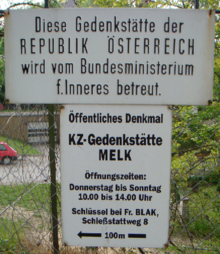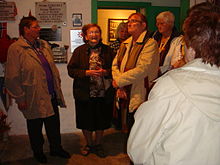Melk concentration camp
The Melk concentration camp was a satellite camp of the Mauthausen concentration camp and existed from April 21, 1944 to April 15, 1945 in what is now the Lower Austrian municipality of Melk . It was a camp for forced laborers who had to drive huge tunnels into the mountain for the armaments production of Steyr Daimler Puch AG near Roggendorf , where the company had ball bearings manufactured. The prisoners were also used to build various barracks in the area and the "Air Force settlement" in Loosdorf . Other victims had to do their job in a large sawmill in Amstetten , which Pölzholz produced for the underground facilities.
Establishment and function of the warehouse
The camp was set up in the barracks of a pioneer unit (today the Birago barracks ) and opened on April 21, 1944 for 500 prisoners.
The pioneer barracks in Melk was divided into two areas: The first area was the prisoner area, consisting of parts of the kuk barracks and several wooden barracks . In autumn 1944 a separate crematorium was built there. The entire prisoner area was surrounded by a double barbed wire fence and a chain of watchtowers with machine gun positions. This area was divided into 18 blocks. There were also workshops, a delousing facility , the infirmary , the office and other facilities.
The second area comprised the rooms for SS crews and the air force and was used to accommodate the guards. Parts of the old pioneer barracks were used for this, but new stone barracks were also built. These were outside the barracks on the other side of the street. Furthermore, a separate residential complex was built in Loosdorf for the guards and their families.
Within exactly one year of existence, up to March 1945 at least 14,390 prisoners, including around a third Jews, were admitted there, around 5,000 of whom were killed due to the inhumane working and living conditions. Many of them were forcibly killed by "hosing down", " shot while trying to escape ", murdered by guards or gassed in the Hartheim Castle killing center . The prisoners, including children and adolescents, had to break the hard quartz rock out of the mountain, which is why the entire project was camouflaged as "quartz". Without occupational safety devices and in the exploitative shift system , the prisoners had to carry out this draining activity, so that there was a high mortality rate among them. For this purpose, "replenishment" was immediately organized from the main warehouse. A separate crematorium was built on the camp grounds, in which the prisoners who died here were cremated, as well as many other murdered prisoners from other camps, mainly from Mauthausen. Her remains, bones and ashes, were dumped into the Danube .
A previously unsolved incident occurred three months after the opening. On July 8, 1944, the 15th US Air Force launched an air raid on the camp, killing around 400 prisoners.
Camp management and guards
The first camp leader was SS-Untersturmführer Anton Streitwieser for a few weeks and then SS-Obersturmführer Julius Ludolf until the camp was dissolved . The guards consisted of 500 Luftwaffe soldiers who were taken over by the Waffen SS in autumn 1944 .
Final phase and liberation of the camp
When US troops approached the camp in mid-April 1945, the prisoners were evacuated: children and young people to the Mauthausen concentration camp and the adults to the Ebensee satellite camp . The original plan was to drive all prisoners into the "Quarz" tunnel and then blow it up. Although the blasting chambers were prepared for this, this plan was not carried out. Instead, large prisoner transports went to Mauthausen on April 11 (1500), to Ebensee on April 13 (4400) and April 15 (1500). All prisoners who were unable to be transported were “hosed down” by an SS medical officer in the “concentration camp sick bay”, that is, murdered by injecting poison into the heart. Most of the prisoners brought to Mauthausen probably perished in the gas chambers there . Some of the Ebenseer prisoners, on the other hand, experienced their liberation by the US troops on May 6, 1945. The Melk concentration camp itself was reached two days later, on May 8, 1945, completely deserted by the Red Army .
After the end of the war
Soon after the liberation, the sub-camp was used for resettlers and, after the area became the property of the city of Melk in 1950, it was restored to its original function as barracks.
memory
The former crematorium of the camp was declared a "Melk Public Monument" at the beginning of 1962. The stone barracks for the guards, built in 1944, were destroyed and apartment blocks were built in their place. In addition, at the “Coppersmith Cross” on the other side of the motorway , the cistern for the concentration camp, which is still in place and built by prisoners, reminds of the history of this extermination site.
The “Melk Public Monument” has housed a permanent exhibition about the Melk concentration camp since May 8, 1992, which was initiated by Dr. Bertrand Perz goes back. A new exhibition has been set up in the memorial, the former crematorium, which uses photos, documents and objects to provide information about the economic background that led to the establishment of the camp as well as the life, suffering and death of the prisoners.
On September 6, 2008, the initiative “ Viertelfestival Niederösterreich” installed a telephone booth on the main square in Melk , in which the names of surviving former prisoners can be called via the “ telephone book ” and an interview with contemporary witnesses can be listened to. In addition, initial information on the Melk concentration camp can be obtained in this cell. The object was placed on November 8, 2008 near the entrance to the memorial.
The memorial site is visited by groups and initiatives who gather information about what is happening at the authentic location, hold commemorations and give lectures. One example is the reflection evening of the Catholic Action of the Diocese of St. Pölten , organized by the Coordinating Committee for Christian-Jewish Cooperation on June 7, 2008 with a service and discussion.
Basic military servants who move into the barracks have been informed about the historical background of the place by trained guides since 2018.
literature
- Wolfgang Benz , Barbara Distel (ed.): The place of terror . History of the National Socialist Concentration Camps . 9 volumes (published until 2008: 8 volumes). CH Beck, Munich 2005, ISBN 978-3-406-52960-3 .
- Hans Maršálek , Kurt Hacker : Short story of the Mauthausen concentration camp and its three largest sub-camps Gusen, Ebensee and Melk . Published by the Austrian camp community Mauthausen, Vienna 1987.
- Bertrand Perz: Melk concentration camp. Brochure accompanying the permanent exhibition in the memorial of the former Melk concentration camp . Vienna 1992.
- Bertrand Perz: Project Quartz. Steyr-Daimler-Puch and the Melk concentration camp . Vienna 1991.
- Bertrand Perz: "New Cavemen". An underground armaments factory built by concentration camp prisoners near Melk on the Danube. In: Photo History , Issue 54, Volume 14, 1994, pp. 45–56.
- PJ Eisenbauer: The forgotten dead of Melk . In: Local history supplement to the official gazette of the Melk District Authority, 11th year, No. 2 and 3, 1985.
- Ladislaus Szücs : roll call. As a doctor in the concentration camp . Fischer, Frankfurt am Main 1995, ISBN 978-3-596-12965-2 .
Individual evidence
- ^ Markus Schmitzberger: Mauthausen subcamp Melk. In: www.geheimprojekte.at. 2015, accessed August 12, 2018 .
- ↑ a b c d Bertrand Perz: KZ Melk , in: Wolfgang Benz, Barbara Distel (ed.): The place of terror . History of the National Socialist Concentration Camps . Volume 4: Flossenbürg, Mauthausen, Ravensbrück , Munich 2006, p. 40ff.
- ^ Quartz Roggendorf: Quartz B9 Roggendorf. Retrieved November 8, 2017 .
- ↑ Melk - Melk Memorial, Mauthausen concentration camp branch (Lower Austria) at www.erinnern.at.
- ↑ Connected to the past. In: www.judeninkrems.at. September 3, 2008, accessed August 12, 2018 .
- ↑ Touching reflection evening in the former Melk concentration camp. Diocese of St. Pölten , accessed on August 12, 2018 .
- ↑ Miriam Steiner: Concentration camp history as part of basic military service. In: noe.orf.at . August 12, 2018. Retrieved August 12, 2018 .
Web links
- Melk Memorial
- The Polish prisoner Jerzy Michnol remembers the time in the Melk concentration camp. A project as part of the Lower Austrian Quarter Festival 2008
- Melk concentration camp - aerial view
- Stollen concentration camp near Roggendorf not under monument protection! A discussion forum deals with placing the Roggendorf bunker under protection
Coordinates: 48 ° 13 ′ 13.8 ″ N , 15 ° 19 ′ 27.4 ″ E

